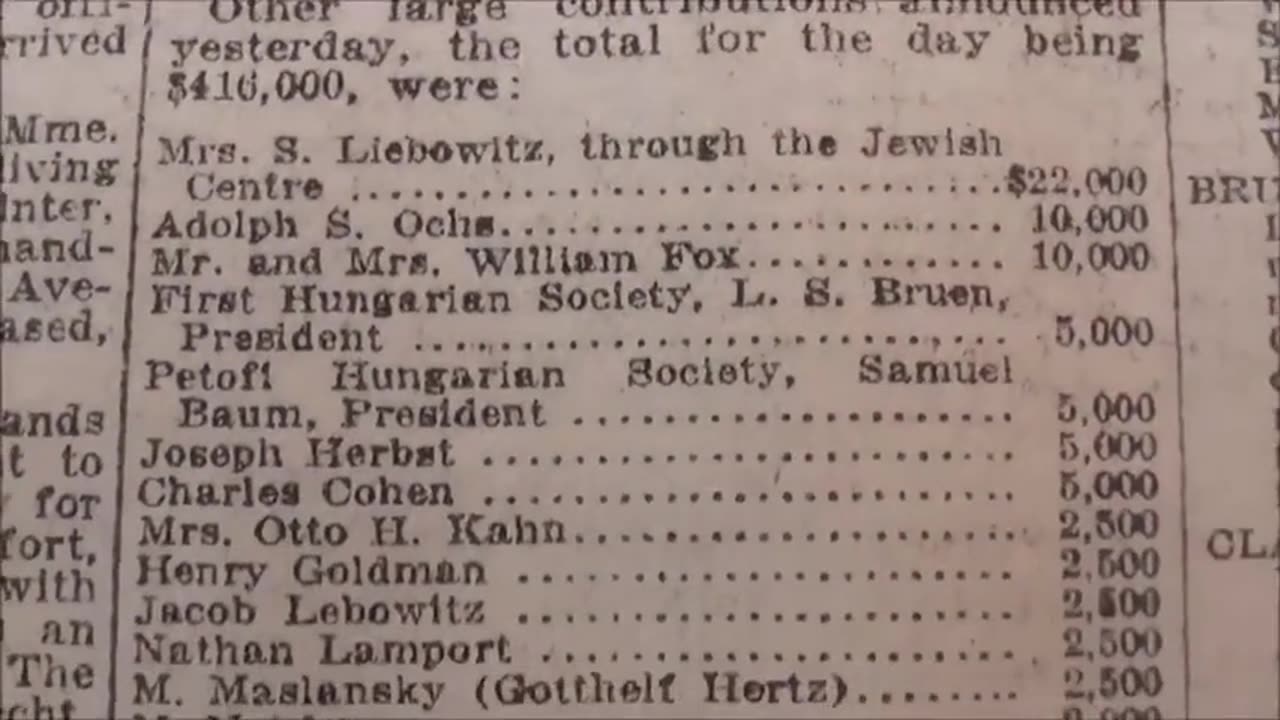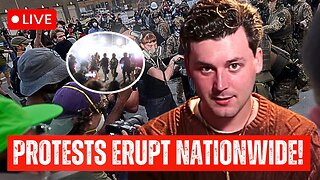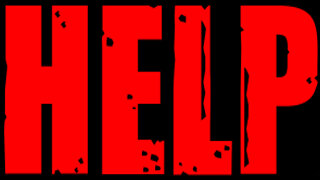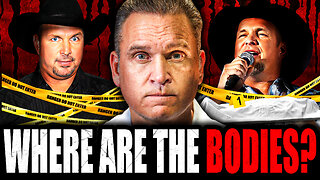Premium Only Content

SHOCKING.!! 6-Mil Jews, predictive programing in news papers years before Hitl3R was ever in power
6-Mil Jews, predictive programing in news papers years before Hitl3R was ever in power
So Yes I See The Numbers Do Not Add Up ? In 1900, the world Jewish population was estimated to be 10,600,000, with the world who having the largest core Jewish population at 6,983,000, followed by the United States with 6,000,000. In Europe, approximately 9.5 million Jews lived in 1933, representing more than 60% of the world's Jewish population at that time, estimated at 15.3 million. The Jewish population grew to around 13 million by the 1970s, but recorded almost no growth until around 2005 due to low fertility rates and assimilation of Jews. The Jewish Encyclopedia article estimates only 314,000 Sephardic Jews at the end of the 19th century, but recent scholarship suggests that this estimate is low.
As of 2022, the world's core Jewish population is estimated to be 16.2 million, with Israel hosting the largest core Jewish population with 6.89 million, followed closely by the United States with approximately 5.7 million. The Jewish population is concentrated primarily in North America and the Middle East-North Africa region, with the remainder found in Europe, Latin America and the Caribbean, Asia and the Pacific, and sub-Saharan Africa. The Pew Forum's estimate of the "core" population of Jews around the world as of 2010 is slightly lower than the Pew Forum's figure of 14 million. The Jewish population is spread throughout many countries, with the highest population concentrations in Israel and the United States.
Before the Nazis seized power in 1933, Europe had a richly diverse set of Jewish cultures. Many of these cultures were dynamic and highly developed. They drew from hundreds and, in some areas, a thousand or more years of Jewish life on the continent.
So 6 Million Jews Killed By Russia In World War One And Now 6 Million More Jews Are Killed By Germany In World War Two ( P.S. So The Total Number Jews Killed Both War's WW 1 & WW 2 Is 12.2 Millions Killed In Total ) ? ?
In 1933, approximately 9.5 million Jews lived in Europe, comprising 1.7% of the total European population. This number represented more than 60 percent of the world's Jewish population at that time, estimated at 15.3 million.
Eastern Europe
The majority of Jews in prewar Europe resided in eastern Europe. The largest Jewish communities in this area were in Poland, with about 3,000,000 Jews (9.5%); the European part of the Soviet Union, with 2,525,000 (3.4%); and Romania, with 756,000 (4.2%). The Jewish population in the three Baltic states totaled 255,000: 95,600 in Latvia, 155,000 in Lithuania, and 4,560 in Estonia. Here, Jews comprised 4.9%, 7.6%, and 0.4% of each country's population, respectively, and 5% of the region's total population.
Central Europe
In prewar central Europe, the largest Jewish community was in Germany, with about 525,000 members (0.75% of the total German population). This was followed by Hungary with 445,000 (5.1%), Czechoslovakia with 357,000 (2.4%), and Austria with 191,000, most of whom resided in the capital city of Vienna (2.8%).
Western Europe
In western Europe the largest Jewish communities were in Great Britain, with 300,000 Jews (0.65%); France, with 250,000 (0.6%); and the Netherlands, with 156,000 (1.8%). Additionally, 60,000 Jews (0.7%) lived in Belgium, 4,000 (0.02%) in Spain, and 1,200 (0.02%) in Portugal. Close to 16,000 Jews lived in Scandinavia, including 6,700 (0.11%) in Sweden, 5,700 (0.15%) in Denmark, 1,800 (0.05%) in Finland, and 1,400 (0.05%) in Norway.
Southern Europe
In southern Europe, Greece had the largest Jewish population, with about 73,000 Jews (1.2%). There were also significant Jewish communities in Yugoslavia (68,000, or 0.49%), Italy (48,000, or 0.11%), and Bulgaria (48,500, or 0.8%). 200 Jews (0.02%) lived in Albania.
Jewish Communities before the Nazi Seizure of Power
Before the Nazis seized power in 1933, Europe had a richly diverse set of Jewish cultures. Many of these cultures were dynamic and highly developed. They drew from hundreds and, in some areas, a thousand or more years of Jewish life on the continent. The diverse nature of individual Jewish communities in occupations, religious practices, involvement and integration in regional and national life, and other areas made for fruitful and varied Jewish life across Europe. In many countries, Jews stood as cultural and political luminaries, and had marched alongside non-Jews in World War I.
In little more than a decade, most of Europe would be conquered, occupied, or annexed by Nazi Germany and its Axis partners, and the majority of European Jews—two out of every three—would be dead.
Toward the end of the 19th century, estimates of the number of Jews in the world ranged from about 6,200,000 (Encyclopedia Britannica, 1881) to 10,932,777 (American Jewish Year Book, 1904–1905). This can be compared with estimates of about half that number a mere 60 years earlier, though for comparison estimates of the total population of Europe show it also to have doubled between 1800 and 1900.
Demography and the Palestine Question (I) 1850s-1948
Jews had settled in Palestine long before Theodor Herzl formulated his ideas on Zionism in The State of the Jews (1896). A small core group of Palestinian Jews were descendants of Jews who had survived the destruction of the Second Temple during the first century, but most were descendants of deportees from the Spanish Reconquista during the sixteenth century. In all, there were some 13,000 Palestinian Jews in 1852, representing about 4 percent of the population of Palestine, concentrated mostly in the districts of Jerusalem , Acre , and Nablus . In the last quarter of the nineteenth century, however, there was a substantial immigration of enterprising Jews who bought Palestinian land, making it possible for the Jewish population there to grow substantially faster than the indigenous Muslim and Christian population
Between 1850 and 1914, the demography of the Jewish community in Palestine was bolstered by the immigration of more than 84,000 Jews (though not all of them settled in Palestine permanently). Furthermore, their natural population growth (due to high birth and low mortality rates) reinforced their presence in Palestine. This demographic advantage is important even today, more than compensating for the decline in Jewish immigration to Israel at the turn of the twenty-first century.
At the start of World War I , Palestine was home to 60,000 Jews, of which 39,000 had Ottoman citizenship, compared to more than 700,000 Ottomans who were Muslim or Christian
https://www.palquest.org/en/highlight/294/demography-and-palestine-question-i
The Jewish presence in Palestine was smaller than in Iraq or Yemen and a bit bigger than in Syria and Lebanon . While the war had a major impact on the demography of Palestinian Jews, this loss was much less than that suffered by other Muslim or Christian Palestinians.
The Balfour Declaration (1917) was the founding act that made it possible for a population of 60,000 Jews in pre-Mandate, Ottoman Palestine to grow into a population of 700,000 Israelis in 1948. This tenfold increase was much less due to natural population growth than to immigration. In the 1930s, the Jews who had been persecuted in Nazi Germany and Europe, and for whom salvation through emigration to elsewhere in Europe or to the New World was refused, streamed into Palestine, which let in a quarter of a million refugees
While there was no move to push out Palestinians at first, the massive arrival of the immigrants created extreme tension, which ultimately led to the expulsion/deportation of the Palestinians in 1948.
Palestinian resistance to the confiscation of power by the British Mandate and the appropriation of land by Jews (even if they had bought it and sometimes at a high price) reached a peak during two periods: the riots of 1920–21 and especially during the al-Thawra al-filastiniyya al-kubra of 1936–39. However, neither the first nor the second uprisings could overthrow the British Mandate or halt Jewish immigration, which was an integral part of the mission given to the Mandate. The reaction of the Palestinian people thus took on a different form: at first political, it eventually became demographic.
Thanks to an exceptional statistical system, the British Mandatory could collect year after year information about the number of births and deaths among the main religious groups in Palestine, which was very new for the region. These statistics reveal that the natural increase of the Palestinian population, regardless of religion and in spite of a high mortality rate, reached record high levels and surpassed that of the Jewish immigrants.
The British statistics become particularly significant, however, when compared with those of neighboring Arab countries, less threatened by a foreign presence. These comparisons show that during the Mandate period, consciously or not, Palestinians resisted by creating large, extended families. Their birth rate surpassed and then remained almost constantly at the highest level in the world. It ranged from a low of 45 per 1,000 in 1942 to a high of 60 per 1,000 (in 1928 and 1930), with an average of 50 per 1,000, or about 9 children per woman. In comparison, the Egyptian birthrate was about 44 per 1,000 and that of Syria, 40. Since the Mandate period, the weapons used by the different parties involved in the conflict have become more and more sophisticated. But this “conventional” weapon of demographic growth, this “revenge of the cradles” so evident under the Mandate, has endured to this day.
The impertinent demography of the Palestinian population was brutally obliterated in only a few weeks by the 1948 War . The deportation of some 750,000 Palestinians reduced the number of remaining Palestinians, who were to become Israeli citizens, to only 156,000 in the new territorial entity, in which were living 700,000 Jews at that time.
During World War I, around 8,500,000 soldiers died as a result of wounds and/or disease. The greatest number of casualties and wounds were inflicted by artillery, followed by small arms, and then by poison gas. The bayonet, which was relied on by the prewar French Army as the decisive weapon, actually produced few casualties.
War was increasingly mechanized from 1914 and produced casualties even when nothing important was happening. On even a quiet day on the Western Front, many hundreds of Allied and German soldiers died. The war raged for more than four years, from August 1914 to November 1918, and resulted in the deaths of more than nine million combatants. As many as seven million civilians also were killed in the war or died as a consequence of it.
Number of military and civilian deaths per country in the First World War 1914-1918
The First World War saw the mobilization of more than 65 million soldiers, and the deaths of almost 15 million soldiers and civilians combined. Approximately 8.8 million of these deaths were of military personnel, while six million civilians or is it (6 million Jews?) Who died as a direct result of the war; mostly through hunger, disease and genocide. The German army suffered the highest number of military losses, totaling at more than two million men. Turkey had the highest civilian death count, largely due to the mass extermination of Armenians, as well as Greeks and Assyrians. Varying estimates suggest that Russia may have suffered the highest number of military and total fatalities in the First World War. However, this is complicated by the subsequent Russian Civil War and Russia's total specific to the First World War remains unclear to this day.
Proportional deaths
In 1914, Central and Eastern Europe was largely divided between the empires of Austria-Hungary, Germany and Russia, while the smaller Balkan states had only emerged in prior decades with the decline of the Ottoman Empire. For these reasons, the major powers in the east were able to mobilize millions of men from across their territories, as Britain and France did with their own overseas colonies, and were able to utilize their superior manpower to rotate and replace soldiers, whereas smaller nations did not have this luxury. For example, total military losses for Romania and Serbia are around 12 percent of Germany's total military losses; however, as a share of their total mobilized forces these countries lost roughly 33 percent of their armies, compared to Germany's 15 percent mortality rate. The average mortality rate of all deployed soldiers in the war was around 14 percent.
Unclarity in the totals
Despite ending over a century ago, the total number of deaths resulting from the First World War remains unclear. The impact of the Influenza pandemic of 1918, as well as various classifications of when or why fatalities occurred, has resulted in varying totals with differences ranging in the millions. Parallel conflicts, particularly the Russian Civil War, have also made it extremely difficult to define which conflicts the fatalities should be attributed to. Since 2012, the totals given by Hirschfeld et al in Brill's Encyclopedia of the First World War have been viewed by many in the historical community as the most reliable figures on the subject.
https://www.statista.com/statistics/1208625/first-world-war-fatalities-per-country/
The Holocaust was the systematic, state-sponsored persecution and murder of six million Jews by the Nazi regime and its allies and collaborators. It took place between 1933 and 1945. In 1933, more than 9 million Jews lived in Europe (1.7% of the total population). By 1945, the Germans and their allies and collaborators had killed nearly two out of every three European Jews. Nazi policies also led to the discrimination, persecution, and murder of millions of others. Explore a timeline of events that occurred before, during, and after the Holocaust.
Influenza pandemic of 1918 killed more people then died in world war 1?
Hard as it is to believe, the answer is true.
World War I claimed an estimated 16 million lives. The influenza epidemic that swept the world in 1918 killed an estimated 50 million people. One fifth of the world's population was attacked by this deadly virus. Within months, it had killed more people than any other illness in recorded history.
The plague emerged in two phases. In late spring of 1918, the first phase, known as the "three-day fever," appeared without warning. Few deaths were reported. Victims recovered after a few days. When the disease surfaced again that fall, it was far more severe. Scientists, doctors, and health officials could not identify this disease which was striking so fast and so viciously, eluding treatment and defying control. Some victims died within hours of their first symptoms. Others succumbed after a few days; their lungs filled with fluid and they suffocated to death.
The plague did not discriminate. It was rampant in urban and rural areas, from the densely populated East coast to the remotest parts of Alaska. Young adults, usually unaffected by these types of infectious diseases, were among the hardest hit groups along with the elderly and young children. The flu afflicted over 25 percent of the U.S. population. In one year, the average life expectancy in the United States dropped by 12 years.
It is an oddity of history that the influenza epidemic of 1918 has been overlooked in the teaching of American history. Documentation of the disease is ample, as shown in the records selected from the holdings of the National Archives regional archives. Exhibiting these documents helps the epidemic take its rightful place as a major disaster in world history.
BEFORE 1933
WWI, its Aftermath, and the Growth of the Nazi Party
Countries across Europe struggled to recover from the devastation caused by World War I after it ended in 1918. This was a time marked by massive social and political change, revolution, and the establishment of new states. In this postwar environment, extreme nationalism, racism, and antisemitism found fertile ground. The Nazi and the Italian Fascist political parties, along with many other similar groups across Europe, emerged from this chaos to become visible threats to new and fragile democracies, including Germany's Weimar Republic.
1933–1938
Prewar Nazi Germany and the Beginnings of the Holocaust
Following Adolf Hitler’s appointment as German chancellor on January 30, 1933, the Nazis and their allies transformed Germany from a multi-party republic into a one-party dictatorship. The Nazi dictatorship implemented radical racial, political, and social policies. During the first six years of Hitler’s rule, German Jews felt the effects of legislation that transformed them from “citizens” to “outcasts.” In the 1930s, the regime also targeted a variety of alleged “enemies of the state” within German society.
1939–1941
World War II and the Mass Killing of Jews
On September 1, 1939, Nazi Germany unleashed World War II by invading Poland. The war radicalized Nazi policies, leading to brutal occupations of conquered territory. German authorities in occupied Poland established ghettos for Jews. They also introduced harsh measures against non-Jewish Poles. Inside Germany and in occupied Polish territories, German physicians and SS staff used gas chambers to kill institutionalized persons with disabilities. In June 1941, German troops invaded the Soviet Union, unleashing a “racial war” that led to the mass murder of Soviet Jews and Soviet prisoners of war. In the weeks and months that followed, Nazi Germany’s leaders decided to carry out the systematic mass murder of Europe’s Jews.
1942–1945
Intensification of Mass Killings
In early 1942, Nazi Germany stood at the height of its power. Germany and its allies controlled most of Europe and even parts of North Africa. The SS had established special killing centers with large gas chambers, expanding the “Final Solution,” the mass murder of European Jews. The perpetrators counted on the cooperation of government agencies, local collaborators, and the support or acquiescence of the general population. Even as the war turned against Germany, the Nazi leadership continued its murderous polices. By May 1945, when the war ended, the Nazis and their allies had killed about 6 million Jews. Millions more people had suffered grievous oppression or death under Nazi tyranny.
AFTER 1945
End of WWII, Aftermath of the Holocaust, and Genocide after 1945
As Allied troops drove German troops towards defeat, they uncovered Nazi camps and massive evidence of Nazi crimes. The war had uprooted millions who were now “displaced persons” (DPs) waiting for repatriation to their home countries. For tens of thousands of Holocaust survivors, the choices were limited and daunting. Allied occupation forces faced enormous responsibilities: housing and feeding DPs, de-nazifying and democratizing Germany, and bringing those responsible for Nazi crimes to justice. This section also addresses genocides that have occurred since the Holocaust.
Real Nazi Meaning and Origin of the Word The Nazi party was the political and military power headed by Adolf Hitler before and during World War II. But what does Nazi stand for in English, and why do people still use it today? Learn all about the meaning and history of the word Nazi, including important facts that are still relevant in modern politics.
What Does Nazi Stand For?
The word Nazi, meaning "a member of the National Socialist German Workers' Party," is short for the German term for National Socialist (Nationalsozialist). The full German name for the party is Nationalsozialistische Deutsche Arbeiterparte, or NSDAP. Along with Adolf Hitler, the Nazi party rose to power in the years leading up to World War II, committed war atrocities and attempted genocide during the war before being defeated by the Allied powers in 1945.
Colloquially, the term can refer to someone who is extremely zealous about something, such as a "grammar nazi" or a "rules nazi." However, the word is typically lowercase in these instances. Historically and politically, Nazi with a capital "N" refers to a person who follows the principles of Nazism.
Nazi Ideology
Although the word socialist appears in the party title for Nazism, the Nazi ideology doesn't have much to do with far-left traditional socialism. Hitler's definition of National Socialism, a platform that serves one's country only, is closer to far-right fascism and authoritarianism on the ideological spectrum.
Attributes of Nazi ideology include:
Totalitarianism - The Nazi party sought sole control of the government and severe punishment of political enemies. The philosophy allowed no dissension among German citizens.
Dictatorship - Adolf Hitler was the unquestioned leader of the Nazi party. As he ascended Germany's political ranks, the German government rapidly shifted from a constitutional monarchy to an absolute dictatorship.
Limited civil liberties - Personal freedom was unimportant to the Nazis, who quickly took liberty from those it persecuted. These actions ranged from arresting people without cause to executing them in concentration camps.
Xenophobia - Nazis wanted to preserve an Aryan race (Nordic heritage) and eliminate all who they deemed to be inferior, especially Jewish people. They put a stop to immigration into Germany and stripped rights from non-German residents.
Nationalism - One of the main Nazi party platforms was the unification of Germany after World War I. Nazis believed in Aufbruch der Nation — "a new start for the nation" — to rebuild after suffering economic and infrastructural losses in the first World War.
Loyalty - Nazis swore loyalty to Adolf Hitler and Nazi Germany. Common Nazi mottos included Alles für Deutschland ("everything for Germany") and Deutschland über alles ("Germany above all").
Sovereign economy - The Nazi economy did not fall into traditional definitions of economic systems. It had characteristics of capitalism (German citizens of non-Jewish ancestry could own property) and a state-run economy (the labor and production market shifted to accommodate the government's war needs).
Although Nazi Germany only existed for 12 years (1933-1945), it made an enormous impact on twentieth-century geopolitical relations. Even the threat of a far-right government's approach to Nazism warrants attention from democratic countries around the world.
Who Coined the Word Nazi?
While it's difficult to know who exactly coined the word "Nazi" as a nickname for Hitler's party, historians generally agree that it wasn't Hitler. In fact, Hitler disliked the term because it was used as an insult by his enemies. As Mark Forsyth writes in The Etymologicon, Nazi had long been a derogatory nickname for the Bavarian peasant name Ignatius, which referred to a stereotypically unintelligent and clumsy person. It transferred well to the German pronunciation of Nationalsozialist. As anti-Hitler Germans fled the country in the 1930s and 1940s, the teasing nickname for Hitler's party became part of international vocabulary.
Party members attempted to reclaim the nickname for their own purposes. Joseph Goebbels, a Nazi propagandist, wrote a pamphlet called Der Nazi-Sozi in 1926 to reclaim the nickname. Leopold von Mildenstein did the same in Ein Nazi fährt nach Palästina in 1934. Some members of the party used the colloquial term, but for the most part, they referred to each other as Nationalsozialisten (National Socialists).
What Does SS Stand For?
When you see the letters SS in reference to Nazis or World War II, it stands for Schutzstaffel ("protective squad" or "protective eschelon"). The SS was a paramilitary group originally tasked with protecting Hitler and the higher-ranking Nazi officers. It evolved from Hitler's private army, the SA (Sturmabteilung or "assault division"), also known as "brownshirts" or "stormtroopers." One of the most prominent SS members was Heinrich Himmler, who commanded the SS and was responsible for splitting the SS from the SA.
As World War II progressed, the SS grew to over 250,000 members and split into subdivisions, including SS Verfügungstruppen ("Dispositional troops"), Totenkopfverbande ("Death's Head Unit") and Waffen SS ("Armed SS"). It worked with Germany's secret state police (Geheime Staatspolizei or "Gestapo") to carry out mass executions, arrest political enemies and operate concentration camps. During the Nuremberg Trials after World War II, the SS was found to be a criminal organization guilty of committing war crimes during the Holocaust.
What Does Neo-Nazi Stand For?
The prefix neo- means "new." Neo-Nazi is a term that describes "new Nazis" — modern political activists who share the core beliefs of World War II-era Nazism. Another common term for a neo-Nazi is "white supremacist," which indicates that a person values members of the white race above all other races.
Unlike traditional Nazis, neo-Nazis value personal freedom and the free market, and they are not a global political force. However, similar to Nazis from the 1930s, neo-Nazi groups are found to be vocal and violent against non-white and non-Christian groups, which is why many neo-Nazi organizations are considered to be domestic terrorists.
The Legacy of Nazism
While it would be convenient to leave the memories of Nazism in history, the party's beliefs live on. In the decades since the fall of Nazi Germany, individuals, small groups and even major governments have veered toward the same nationalist and xenophobic philosophies as those held by Nazis. Learning more about other fascist governments in history can round out our knowledge on how these forces take power — and how concerned parties can take it back.
Thanks for writing us.
Untold Story of Swastikas' - A film about the true history of Swastikas' in Hinduism
What's is the meaning of Swastikas'? Where did it originate from? Is it that many civilizations used Swastikas' as part of their culture? Answers to all these questions. What's is the meaning of Swastikas'? Where did it originate from? Is it that many civilizations used Swastikas' as part of their culture? Answers to all these questions. Nazi - Swastika The Swastika is a sacred symbol in Hinduism, Buddhism, and Jainism. It is also a sign of spiritual purity.
I Pledge Of Allegiance To The Flag Was A Marketing Ploy Designed To Sell Flags
Americans know the Pledge of Allegiance very well – the great majority of US states require school children to recite it every single morning. But not many of us know the true history of the Pledge of Allegiance.
While it's true that the Pledge of Allegiance was created as a way to instill patriotism in American kids, it's also so much more than that. The Pledge has gone through several transformations, each of which provides a really interesting insight into the fears and desires of the United States at a particular point in history.
Americans know the Pledge of Allegiance very well – the great majority of US states require school children to recite it every single morning.
While it's true that the Pledge of Allegiance was created as a way to instill patriotism in American kids, it's also so much more than that.
The Pledge of Allegiance has also stirred up controversy over the years, with its original salute (too close to the Nazi salute for comfort) and the addition of "under God." But most people aren't even aware of one of its hidden controversies – that it was written to sell flags for a magazine. Wow.
There's documentary on Rumble that shows not only is the Swastika from eastern culture, it's very much in European culture for centuries. Ancient potteries, frescos, carvings, metal casting and much more. I'd say the Swastika meant to Hitler and Germany was prosperity. 99% of the people do not know the details of treaties of Versailles and Belfour, the worst was the land grab, and the reparations to Jews not even living in Europe at the time. Germany was Handcuffed. After WW1,Admiral of Fleet for HMS was Winston Churchill, he blocked all enter trees of ships delivering food to Germany, almost 1 million German civilians starved to death.
Heil Arnold Schwarzenegger Don’t Become A Nazi Loser Like My Dad Covid-19 Shot
Arnold Schwarzenegger Say Don’t Become A Nazi Loser Like My Dad And Get Your Covid-19 Death Shots Today Or You're A Schmuck Too. The Weight of what Arnold Schwarzenegger Experienced during a visit to the Nazi Death Camp at Auschwitz was “heavier than any squat I’ve done before,” the actor and retired professional bodybuilder said in a video released Tuesday directed at the rising tide of antisemitism seen heralded by the likes of Kanye West and NBA star Kyrie Irving. In the 12-minute video, Schwarzenegger talks directly to those “who might have already stumbled into the wrong direction,” urging them to dismiss conspiracies surrounding Jewish people, along with race, gender and sexual orientation. “I’ve seen enough people throw away their future for hateful beliefs,” Schwarzenegger says, before referencing his Nazi father, Gustav Schwarzenegger, who he watched “broken” as a child growing up in Austria after the Second World War. “They felt like losers... they fell for a horrible, loser ideology,” Schwarzenegger said of the men he was surrounded by as a kid. “They were lied to and misled into a path that ended in misery… they bought into the idea that the only way to make their lives better was to make other lives worse... It breaks you… it is the path of the weak… there has never been a successful movement based on hate.” Schwarzenegger echoed comments about his father in March 2022 in a video plea to Russians to end the war in Ukraine, revealing Gustav was a German soldier during the siege of Leningrad.
You Will Never Trust Another Celebrity After Watching This Corrupt U.S.A. Governments.
Once you see this you'll have no faith in these people again! The system-serving airheads that should be tried and imprisoned for crimes against humanity like most politicians, oligarchs, globalists and most medias.
Come on Arnold look at the body he made for you, you are Daddy's little squirt, you should be thankful for that, you could have had parents that were 3 foot tall and overweight, hard to make a race horse from an ass, right. You should be pushing everyone out of your way and remind them your father was in the most powerful army ever. I would rather get the gas than stepping on a land mine that blows all three legs off, dead is dead, doesn't matter if from the gun or the knife, the Jews were lucky they only lost 6 Million out of 100 Million others which leaves 94 Million, you never hear those folks bellyaching the same story over and over for 80 years or so. Everybody knows war is hell, for everyone not only Jews..
Israel Surprise Attack On United States Navy Ship USS Liberty 34 Dead 171 Wounded
Israel Surprise Attack On United States Navy Ship USS Liberty incident was an attack on a United States Navy technical research ship (spy ship), USS Liberty, by Israeli Air Force jet fighter aircraft and Israeli Navy motor torpedo boats, on 8 June 1967, during the Six-Day War. The combined air and sea attack killed 34 crew members (naval officers, seamen, two marines, and one civilian NSA employee), wounded 171 crew members, and severely damaged the ship. At the time, the ship was in international waters north of the Sinai Peninsula, about 25.5 nmi (29.3 mi; 47.2 km) northwest from the Egyptian city of Arish.
The documents also suggest that the U.S. government, anxious to spare Israel's reputation and preserve its alliance with the U.S., closed the case with what even some of its participants now say was a hasty and seriously flawed investigation.
In declassifying the most recent and largest batch of materials last June 8, the 40th anniversary of the attack, the NSA, this country's chief U.S. electronic-intelligence-gatherer and code-breaker, acknowledged that the attack had "become the center of considerable controversy and debate." It was not the agency's intention, it said, "to prove or disprove any one set of conclusions, many of which can be drawn from a thorough review of this material,"
An Israeli Foreign Ministry spokesman, Mark Regev, called the attack on the Liberty "a tragic and terrible accident, a case of mistaken identity, for which Israel has officially apologized." Israel also paid reparations of $6.7 million to the injured survivors and the families of those killed in the attack, and another $6 million for the loss of the Liberty itself.
The Israeli Air Force had gained control of the skies on the first day of the war by destroying the Egyptian air force on the ground. America was Israel's ally, and the Israelis knew the Americans were there. The ship's mission was to monitor the communications of Israel's Arab enemies and their Soviet advisers, but not Israeli communications. The Liberty felt safe.
Then the jets started shooting at the officers and enlisted men stretched out on the deck for a lunch-hour sun bath. I remembered watching a Jewish officer cry when he saw the blue Star of David on the planes' fuselages. At first, crew members below decks had no idea whose planes were shooting at their ship.
Thirty-four died that day, including Blue, the only civilian casualty. An additional 171 were wounded in the air and sea assault by Israel.
https://www.chicagotribune.com/chi-liberty_tuesoct02-story.html
Prior to the Holocaust, there were thriving Jewish communities across the world.
The largest Jewish populations were located in Eastern Europe, with communities numbering 3,000,000 in Poland, 2,525,000 in Russia, and 980,000 in Romania. In many large Eastern European cities and towns, such as Warsaw in Poland, Jews fully embraced their country’s culture while also observing traditional Jewish customs. In Western Europe, there were also many sizeable Jewish communities, with 300,000 Jews living in Britain, and 565,000 living in Germany, for example. Here, most Jews were assimilated into the culture of the country in which they lived.
However, not all of Europe was as assimilated, or partially assimilated, as Western Europe and the larger towns and cities of Eastern Europe. Cultural separation was more apparent in rural areas of Eastern Europe, such as Poland and Russia. Here, small towns or villages called ‘Shtetls’ were comprised mainly of Jews. In Shtetls, people aimed to live a simple, traditional, life focused around religion, community, and family.
After the Nazis came to power and antisemitism intensified, Jewish life in Europe changed forever. This section uses case studies to demonstrate the diversity of pre-war Jewish life.
NY rabbi: ‘Not even 1 million’ Jews killed in Holocaust Yosef Mizrachi claims high assimilation rates inflated estimates; ‘he doesn’t know what he’s talking about,’ historian says A controversial ultra-Orthodox rabbi based in New York has said that fewer that one million Jews were killed in the Holocaust, claiming most of those counted among the usually cited figure of six million were not Jewish according to rabbinical law.
In a video posted online, Rabbi Yosef Mizrachi can be seen saying that high assimilation rates in pre-war Europe and broad Nazi definitions have exaggerated the numbers of Jews recorded as killed by the Nazis during the Holocaust. At least five million of the six million were “total goyim,” Mizrachi told the crowd, adopting a Hebrew word for non-Jews that many consider pejorative.
“The truth, I am telling you, is that not even one million Jews were murdered,” Mizrachi said, trashing accepted historical accounts. “A lot of non-Jews were meshed into the count, but in truth, how many Jews really were killed?”
Originally from Israel, Mizrachi moved to the United States in his twenties and received rabbinic ordination there. In the past decade he has been teaching at the Ohr Yeshiva in Monsey, New York, and producing kiruv or Jewish outreach, videos.
According to his website, DivineInformation.com, Mizrachi “has spoken in over 5,000 lectures worldwide as well participated in many weekend seminars, radio shows and other Hebrew and English events in which he enriched the knowledge and awareness of Judaism among thousands of Jews who once were lacking Jewish awareness whatsoever.”
In the video, one of thousands on his YouTube page — which has amassed over a million views — Mizrachi says it is “very simple” to explain his estimates for the actual number of Jewish victims in the Holocaust.
“If you look at the percent of assimilation that there was in Europe, which already reached 80 percent, it’s reasonable to assume that 80 percent of the 6 million were not-Jews,” Mizrachi said.
“If your grandfather from your father’s side was Jewish, and the rest were non-Jews, [you went] to the gas chambers. They also put in the wives of Jews that were entirely non Jewish. If she hid him, or they were hidden by non-Jews, if they caught them, they killed them also,” he said in an apparent reference to the Nazis’ definition of Jewishness, which sufficed with a single Jewish grandparent.
While historians differ on the exact number of Jews killed at the hands of the Nazis, the most commonly cited figure for the total number has been six million with near-universal agreement among Holocaust scholars. According to British historian Martin Gilbert, the total number of victims is just under six million—around 78% of the 7.3 million Jews in Nazi-occupied Europe at the time.
Efraim Zuroff, director of the Simon Wiesenthal Center’s Israel office and a Holocaust historian and Nazi hunter, said there was “absolutely no basis” to Mizrachi’s comments.
There is “no historical truth” to the claims made in the video, both regarding the number of Jews killed and the Nazi definitions of who is considered Jewish, Zuroff told The Times of Israel Thursday.
“The most populous Jewish communities were in Eastern Europe, and there, intermarriage wasn’t even an issue. Yes, there was some intermarriage in Germany and other places but it is a tiny percentage,” he said.
Regarding the claim that many of those included in the tally were not Jewish according to halachic law, Zurroff said: “Half-Jews, as the Nazis called them, were only persecuted as Jews if they were connected to the Jewish community. He doesn’t know what he is talking about.”
Zurroff, who has played a key role in bringing indicted Nazi and fascist war criminals to justice, said the use of false facts served a sinister goal.
“He is doing two despicable things: He’s warning Jews that lack of observance could cause another Holocaust. He is also mocking Jews who are not religious,” he said.
No stranger to controversy, Mizrachi has faced criticism before over comments relating to the Holocaust.
In a lecture posted in 2013 titled “Why Did The Holocaust Happen? Torah Codes, Having Faith in God No Matter What,” Mizrachi suggested the behavior of non-religious Jews as a cause for Nazi atrocities and warned that slack observance could bring about “further tragedy.”
Conversely, he said, in Arab countries, where he claims Jews were largely religious, there had been “no Hitler, no Holocaust.” In other videos he claimed that Down’s Syndrome and autism are “punishments for sins committed in a previous life.”
History Gulag And Russia Jews Holocaust And U.S.A. Concentration Sex Slave Camps
U.S.A. History China Gulag And Russia Jews Goulag Creation of a system of concentration and correctional labor camps began in the Soviet Union in 1919 but “blossomed” during Stalin’s reign of terror. The word Gulag or Goulag is actually an acronym (used from 1930) for (Glavnoye Upravleniye LAGerey), or Main Camp Administration, which was a special division of the secret police and the Soviet Ministry of the Interior overseeing the use of the physical labor of prisoners. Alongside criminals and recidivists, the majority of Goulag prisoners were completely innocent people locked up for a broad variety of political reasons – on the basis of trumped up charges or ethnicity, or even without apparent cause.
Nazi-Japanese-U.S.A. Concentration Camps Discipline, Punish, Exploit And Murder
Nazi Germany was a land of camps. The Nazis set up many different types of camps: camps to discipline, punish, exploit and murder. Concentration camps stood at the center. They helped to establish Nazi rule, led the brutal assault on outsiders and opponents, and engaged in the murderous war against Jews. More than 6 to 7 million men, women and children died in concentration camps between 1933 and 1945. This page lists the main camp complexes under the SS Inspectorate of Concentration Camps and the WVHA-D (with the exception of the special camp Hinzert and the training camp Debica). Other Nazi camps, including death camps like Treblinka, Sobibor, Belzec and Chelmno, are not included. Please note that prisoner and mortality figures are often rough estimates. Also, as many prisoners went through several camps, they were often counted more than once.
Six million Jews died in the Holocaust. Jewish communities across Europe were shattered. Many of those who survived were determined to leave Europe and start new lives in Israel or the United States. The population shifts brought on by the Holocaust and by Jewish emigration were astounding.
According to the American Jewish Yearbook, the Jewish population of Europe was about 9.5 million in 1933. In 1950, the Jewish population of Europe was about 3.5 million. In 1933, 60 percent of all Jews lived in Europe. In 1950, most Jews (51 percent) lived in the Americas (North and South combined), while only a third of the world's Jewish population lived in Europe.
The Jewish communities of eastern Europe were devastated. In 1933, Poland had the largest Jewish population in Europe, numbering over three million. By 1950, the Jewish population of Poland was reduced to about 45,000. The Soviet Union had the largest remaining Jewish population, with some two million Jews. Romania's Jewish population was nearly 757,000 in 1930 and fell to approximately 280,000 (1950). Most of these demographic losses were due to the Holocaust, the rest to postwar emigration from Europe.
The Jewish population of central Europe was also devastated. Germany had a Jewish population of 525,000 in 1933 and just 37,000 in 1950. Hungary had 445,000 in 1933 and 190,000 in 1950. Czechoslovakia's Jewish population was reduced from about 357,000 in 1933 to 17,000 in 1950 and Austria's from about 191,000 to just 18,000.
In western Europe, the largest Jewish communities remained in Great Britain, with approximately 450,000 Jews (300,000 in 1933) and France, with 235,000 (250,000 in 1933). In southern Europe, the Jewish population fell dramatically: in Greece from about 73,000 in 1933 to just 7,000 in 1950; in Yugoslavia from about 70,000 to 3,500; in Italy from about 48,000 to 35,000; and in Bulgaria from 50,000 in 1933 to just 6,500 in 1950 (the reduction in the Bulgarian Jewish population resulted from postwar emigration). The demographic focus of European Jewry thus shifted from eastern to western Europe.
Before the Nazi takeover of power in 1933, Europe had a vibrant and mature Jewish culture. By 1945, most European Jews—two out of every three—had been killed. Most of the surviving remnant of European Jewry decided to leave Europe. Hundreds of thousands established new lives in Israel, the United States, Canada, Australia, Great Britain, South America, and South Africa.
-
 1:13
1:13
EXPOSE & SHARE EVERYTHING
1 day ago⚠️🔥SHARE🔥⚠️5G uses microwaves to silently inject radiation (Dirty Energy) into your body....
71 -

BlackDiamondGunsandGear
3 hours agoAre You that guy? / Carrying a Pocket Pistol /After Hours Armory
17.6K -
 LIVE
LIVE
Camhigby
4 hours agoLIVE - Riot Watch Portland, DC, NC
289 watching -
 2:54:58
2:54:58
CAMELOT331
6 hours agoYouTube Just Told Me I OWE THOUSANDS $ TO THEM... update
26.8K5 -
 2:00:53
2:00:53
Tundra Tactical
13 hours ago $1.95 earned🛑LIVE AT 9PM CST!! Your Government Hates Your Guns : DOJ Holds Firm On National FIREARMS ACT
18.2K -

DLDAfterDark
4 hours ago $3.20 earnedAre YOU The Guy That Ruins Thanksgiving?? - God Guns & Gear
19.9K -
 2:58:31
2:58:31
NewsTreason
5 hours agoDECLAS w/ Rambo & Dave: Nuremberg 2.0 | MTG Exits Stage Left | Mamdani Psyop Confirmed, 8pm EST
68.5K63 -
 LIVE
LIVE
meleegames
5 hours agoSONG REQUESTS CLOSED - Melee Music - Beat Hazard 3 - Devil Inside
131 watching -
 2:13:31
2:13:31
The Connect: With Johnny Mitchell
12 hours ago $3.28 earnedIs Garth Brooks A Serial Killer? Exposing The Dark Secrets Of Country Music's Biggest Star
13.3K4 -
 1:00:49
1:00:49
MattMorseTV
6 hours ago $89.26 earned🔴Massive VICTORY in the SUPREME COURT.🔴
103K138